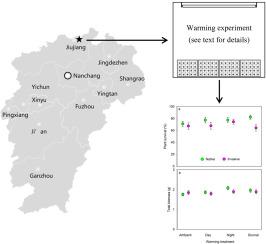Science of the Total Environment ( IF 9.8 ) Pub Date : 2020-06-30 , DOI: 10.1016/j.scitotenv.2020.140624 Zheng-Sheng He 1 , Wei-Ming He 2

|
Both climate warming and biological invasions are primary threats to species diversity and its functioning. Although asymmetric climate warming (i.e., nighttime temperatures increasing faster than daytime temperatures) has long been recognized, its effects on plant invasions remain poorly explored. We report on one field experiment that compared the responses of 18 native plants and 17 invasive plants to three warming regimes: daytime warming (07: 00–19:00), nighttime warming (19:00–07:00), and diurnal warming (07:00–07:00). We found that invasive and native plants exhibited similar survival under the daytime and nighttime warming; however, invasive plants had lower survival than native plants under the diurnal warming. Regardless of warming conditions, invasive and native plants were similar in total biomass, leaf and root areas, biomass allocation, temperature sensitivity, and phenotypic plasticity. Across invasive and native plants, nighttime warming increased total biomass, but daytime and diurnal warming did not. In addition, three warming treatments differentially influenced temperature sensitivity or phenotypic plasticity. Our findings show that plant invaders might not profit more from asymmetric climate warming than natives in tolerance, growth, and plasticity, and also highlight that considering the disparate effects of asymmetric climate warming may be useful for assessing plant invasion outcomes.
中文翻译:

不对称的气候变暖对植物入侵者的好处不比本地人大。
气候变暖和生物入侵都是对物种多样性及其功能的主要威胁。尽管人们早已认识到不对称的气候变暖(即夜间温度升高快于白天温度),但对植物入侵的影响仍未得到很好的研究。我们报告了一项野外实验,该实验比较了18种本土植物和17种入侵植物对三种变暖方式的响应:白天变暖(07:00–19:00),夜间变暖(19:00–07:00)和昼夜变暖(07:00–07:00)。我们发现,在白天和晚上的变暖下,外来入侵植物和本地植物都表现出相似的存活率;然而,在日增温下,入侵植物的存活率要低于天然植物。无论变暖条件如何,外来入侵植物和本地植物的总生物量,叶和根部区域都相似,生物量分配,温度敏感性和表型可塑性。在入侵植物和本地植物中,夜间变暖增加了总生物量,但白天和昼夜变暖却没有。此外,三种加热处理对温度敏感性或表型可塑性有不同的影响。我们的发现表明,植物侵害者从不对称气候变暖中获得的利益可能不会比本地人在耐受性,生长和可塑性方面获得更多收益,并且还强调指出,考虑不对称气候变暖的不同影响可能有助于评估植物入侵的结果。三种升温处理对温度敏感性或表型可塑性有不同的影响。我们的发现表明,植物侵害者从不对称气候变暖中获得的利益可能不会比本地人在耐受性,生长和可塑性方面获得更多收益,并且还强调指出,考虑不对称气候变暖的不同影响可能有助于评估植物入侵的结果。三种升温处理对温度敏感性或表型可塑性有不同的影响。我们的发现表明,植物侵害者从不对称气候变暖中获得的利益可能不会比本地人在耐受性,生长和可塑性方面获得更多收益,并且还强调指出,考虑不对称气候变暖的不同影响可能有助于评估植物入侵的结果。



























 京公网安备 11010802027423号
京公网安备 11010802027423号